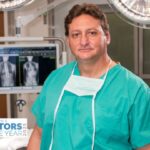Dr. David Siambanes, director of the Children’s Scoliosis Center at St. Joseph’s Children’s Hospital and founder of Children’s Cerebral Palsy, is educating parents of children living with cerebral palsy (CP) on effective pain management tips and various techniques and approaches for alleviating the pain associated with CP.
Before we dive into pain management tips for cerebral palsy, it is best to know what the condition is. According to the Center for Disease Control and Prevention (CDC), cerebral palsy is a group of disorders that affect a person’s ability to move and maintain balance and posture and is the most common motor disability in childhood. CP impacts a child’s ability to control their muscles, oftentimes causing pain and discomfort for the approximately 800,000 people living with CP across the U.S.
“Alleviating pain in children can have positive physical and mental impacts during critical years of development,” said Siambanes, a board-certified orthopedic surgeon who is fellowship-trained in both pediatric orthopedics and spinal deformities. “We want parents to know there are a number of different options short of surgery that can ease your child’s pain and provide an opportunity to live a more comfortable life.”
Siambanes says children with minimum pain or discomfort can relieve their symptoms by enrolling in physical and occupational therapy sessions, where a child can engage in various stretches and exercise regimens intended to improve muscle and joint flexibility. In some cases, a child with CP may have the option to be fitted with orthoses or braces designed to help support weakened muscles.
Some children with CP experience a moderate level of pain. Parents in search of a solution can turn to non- or minimally-invasive treatment options, including radiofrequency, neuromodulation or nerve ablation to target pain receptors, implanting a stimulator on the spinal cord to alter a child’s pain receptors, or injecting Botox into areas experiencing frequent muscle spasms to help numb the pain.
While surgery is considered a last resort for CP pain management, it is sometimes the only option available for children experiencing severe levels of pain. In these cases, surgical procedures generally fall into three categories:
- Orthopaedic surgery – This procedure is recommended for children with spastic CP. Orthopaedic surgeons can increase the length of tendons and muscles in a person’s legs to make walking and moving less painful.
- Spinal fusion – Spinal fusion procedures permanently connect two or more vertebrae, eliminating motion between them and providing stability. Spinal fusion involves techniques designed to mimic the normal healing process of broken bones and can improve a child’s organ function as they grow.
- Selective Dorsal Rhizotomy – Selective Dorsal Rhizotomy (SDR) is a surgery done on the lower spinal cord to reduce spasticity in the legs. Certain abnormal nerve fibers that cause high muscle tone are cut. This allows the muscles to relax by identifying and sectioning only the nerve fibers that contribute to spasticity.
The most appropriate treatment depends on different factors, including a child’s stage of development and form of CP. Siambanes advises parents of children living with CP to consult their pediatric physician to determine the right option for managing their pain. If you’re a parent of a child with cerebral palsy and have questions, visit our Contact page to get in touch.






